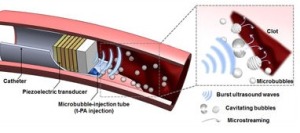por
Lauren Dubinsky, Senior Reporter | June 15, 2017

The intravascular forward-looking
ultrasound tool
Courtesy of Scientific Reports
Researchers in North Carolina have developed an ultrasound tool that can help physicians better target blood clots that cause deep vein thrombosis.
The Centers for Disease Control and Prevention estimates that between 60,000 and 100,000 Americans die of DVT per year – 10 to 30 percent of whom die within one month of diagnosis. The standard treatment involves systemically administering thrombolytic drugs and catheter-based procedures.
“Systemic administration of thrombolytic drugs is slow and ineffective and carries risks of extensive bleeding,” Xiaoning Jiang, one of the researchers and professor at North Carolina State University, told HCB News. “Catheter-based mechanical thrombectomy is highly invasive and damages the vessel wall by removing the endothelial lining adjacent to the clot.”
The existing intravascular ultrasound tools for breaking down blood clots emit ultrasound waves laterally, which is a less targeted approach and can result in damage to surrounding blood vessels. The new ultrasound tool can better target the clot since it can be aimed straight ahead.
“The existing intravascular sonothrombolysis transducer uses a side-viewing approach, which is effective for partially occluded vessels but precludes treatment of completely occluded vessels,” said Jiang.
A technique that uses a diamond-tipped drill to “chew” through the clots is more targeted, but it breaks the clot into relatively large pieces. Because of that, higher doses of blood-thinning drugs are required, which come with risks.
The new ultrasound tool also works like a drill, but breaks the clot down into very small particles so high doses of blood thinners are not needed.
The tool is also equipped with an injection tube that allows users to inject microbubbles at the site of the clot. That makes the ultrasound waves more effective at breaking down the clot.
Jiang and his colleagues at NC State and the University of North Carolina at Chapel Hill tested a prototype of the tool in a synthetic blood vessel using blood from a cow. They found that 90 percent of the clot could be dissolved in 3.5 to 4 hours without using blood thinners, compared to the 10 hours it takes with conventional ultrasound tools and blood thinners.
The research team is in the process of securing funding in order to conduct trials with an animal model. They have also filed a patent on the technology and stated they are interested in working with industry partners to develop the tool.
Back to HCB News
